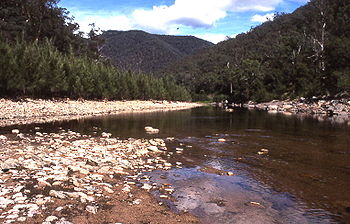- Coxs River
-
Coxs River is a river in the Blue Mountains area of New South Wales, Australia.
Contents
Description and History
Coxs River begins just west of the city of Lithgow and flows south for many kilometres before turning east to flow into Lake Burragorang, the lake that was created when Warragamba Dam was built. It is thus a major tributary to Warragamba Dam, which supplies most of the water for Sydney, the capital of New South Wales.
To the Aborigines who lived in the area for thousands of years before white settlement, Coxs River was one of two corridors that could be used to cross the Blue Mountains, the other being the Bilpin Ridge, now the site of Bells Line of Road. Coxs River was the easiest way to cross the mountains, but this fact was unknown to the European settlers, for whom the mountains were a seemingly impassable barrier.
A former convict, John Wilson, may have been the first European to cross the Blue Mountains. Wilson arrived with the First Fleet in 1788 and was freed in 1792; he promptly went bush, living with the Aborigines and even functioning as an intermediary between them and the settlers. In 1797 he returned to Sydney, claiming to have explored up to a hundred miles in all directions around Sydney, including across the mountains. His descriptions and observations were generally accurate, and it is possible that he had crossed the mountains via the Coxs River corridor, guided by the Aborigines.[1]
On the 24th June 1815 the naming of the Coxs River is mentioned in the Historical Records of Australia (Series I, Vol. VIII p. 572) It states: The junction of these two streams a very handsome river, now called by the Governor "Cox's River" which takes its course...and empties itself into the River Nepean..." The Nepean then becomes the Hawkesbury River and flows into the Pacaific Ocean at Broken Bay. Governor Macquarie named both Coxs River and Coxs Pass in honour of William Cox (pioneer)1764 - 1837[2]military officer, roadmaker and builder.
Pollution
As of 2008, there were concerns about water quality in upper Coxs River. Testing carried out by researchers from the Blue Mountains Conservation Society showed that this part of the river had high levels of heavy metals including zinc, copper and manganese, 125 times more sulphate than surrounding streams and only 5% of the oxygen that fish need. The pH level -- a test of acidity -- was up to 1000 times higher than that of neighbouring creeks, while the river was 80 times as salty as it should be. The Sydney Catchment Authority confirmed that the test was accurate, but said the water gets safer to drink in the lower river, approaching Warragamba Dam. The Department of Environment and Climate Change said that the contamination could be caused by Delta Electricity's Wallerawang power station reusing its water as a result of drought. Delta stated that it was operating within the conditions of its licence.[3]
In 2009, Dr Ian Wright of the University of Western Sydney reported that the water flowing into Coxs River contained high levels of copper, boron and other metals at "many times" the levels found upstream of the Wallerawang power station. High arsenic levels were found down stream of the plant, although it was diluted further downstream and was not thought to pose a risk to humans. The Blue Mountains Conservation Society was taking a case to the Land and Environment Court of New South Wales with the backing of Environment Defenders Office of New South Wales, intending to argue that Delta Electricity are polluting Coxs River. The Society also intended to challenge the New South Wales system of environmental licences. The Society's president, Tara Cameron, said: "These licences are just licences to pollute. They are just allowing the status quo and making people feel good without actually protecting the environment."[4] Journalists Ben Cubby and Erik Jensen maintained that the State Government had known about the pollution for over two years.[5]
Activities
Access
- Vehicle access is available at many locations along the river. There are several areas close to Hartley. As the river progresses towards Lake Burragorang, vehicle access is not permitted.
- Hiking is the most popular access method to the Coxs River. There are several well maintained historic walks that follow along scenic sections of the river. One of the most popular is the Six Foot Track.[6]
- Horse riding is another popular way to enjoy the Coxs river. There are several tour operators in the Megalong Valley that offer day and overnight rides.
References
- ^ The Blue Mountains Rediscovered, pp.76-77
- ^ http://www.adb.online.anu.edu.au/biogs/A010248b.htm
- ^ Sydney Morning Herald, 2nd December 2008, p.5
- ^ Sydney Morning Herald, 18th June, 2009, p.1
- ^ Sydney Morning Herald, 19th June, 2009, p.1
- ^ Sydney and Blue Mountains Bushwalks, Neil Paton (Kangaroo Press) 2004, p.240
Categories:- Rivers of New South Wales
- Blue Mountains, New South Wales
- New South Wales geography stubs
Wikimedia Foundation. 2010.

